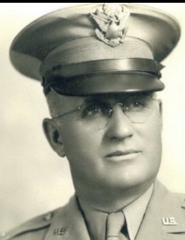Miles Tells of Flight Through Flak
By Frank Miles
Somewhere in the Mediterranean War Theater (IDPA) - One bright recent morning the writer climber into a B-17 (Flying Fortress) in a formation of 28 bombers and several P-38's (Fighters) going out to blast a nazi-held port in northern Italy. (An Associated Press report said he went on a raid on industrial targets in Genoa.)
Most of the men, including flyers, with whom I discussed my intentions to make such a flight advised strongly against it.
"Why should you do anything like that?" was the usual comment.
Major John W. Sawyer, of Chicago, a World War I veteran of the intelligence section of the group in which my younger son (the late Lt. William Miles) flew as a pilot, professed to be almost indignant.
"Newspapermen are nuts." he growled, after listening to reasons I advanced for my impending action.
The 10 members of the crew whose green guest I was formed a close circle and with bowed heads prayed for one another before the take off. Plane Pilot was Lt. Robert R. "Red" Taylor, of Nashville, Tenn.
Formation commander that day was Col. Frank Kurtz, 33, born at Davenport, Iowa, who was coauthor with William L. White of Emporia, Kans., of the classic story of the South Pacific, "Queens Die Proudly." He refers to himself as an "Iowa farm boy." Mrs. Kurtz makes the home in Omaha now. The colonel confided he expected to be a father soon.
His ship was in the lead -- No.1 Ours was at his left--No.3.
We were 3 1/2 hours enroute to target, which was reached at an altitude of 25,000 feet. The passenger started with a leather jacket on over a cotton shirt, and by the time the zero seconds came had acquired a life preserver, parachute, oxygen mask, fleece-lined boots, wool and leather gloves, a flak suit and steel helmet. We had been given some advice as to what to do and where to go if we had to land in enemy territory at a daylight briefing.
As we neared the nazi base, white puffs flashed past the window just behind the pilots seats from where I was observing. They were from 105 millimeter flak guns. Soon came black puffs from 80 millimeter guns. Explosions near and underneath us could be heard and felt.
Colonel Kurtz' plane was out of my vision when we got over target but I saw No. 2 to his right and across from us let loose 10 500-pound bombs, and in that moment realized our bombs were away.
On the turn back over the Adriatic Sea I saw a long line of our silver air monsters flying through a hell of flak and raining hell with their bombs. (A beautiful, awe-inspiring picture!)
No nazi fighter craft came out.
The homeward trip was uneventful so far as we were concerned. A count showed our plane had 12 new holes in its side, wings and tail. When we landed, a jeep took the crew and me to the building, where all returning crews are interrogated. Then we had doughnuts and lemonade served by the Red Cross.
Lieutenant Taylor told me he and his crew had made me an honorary member.
I thanked and shook hands with each of these youngsters, smiling to conceal a terrific weariness which had come over my mind and body. That night, by the cot of an absent chaplain on which I slept, I said a prayer for the brave boys who had flown in that formation and everywhere else for American that day and every other day and for those who had gone and would go on their last flight before the war ended.
Pictures of the mission on which I had gone proved our bombers were remarkably accurate.
Maybe this newspaperman is "nuts", but it was a great experience.
Source: Mason City Globe-Gazette, September 21, 1944
![]()

